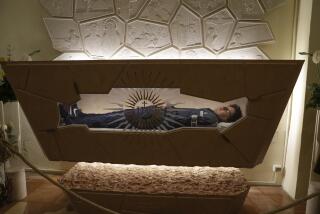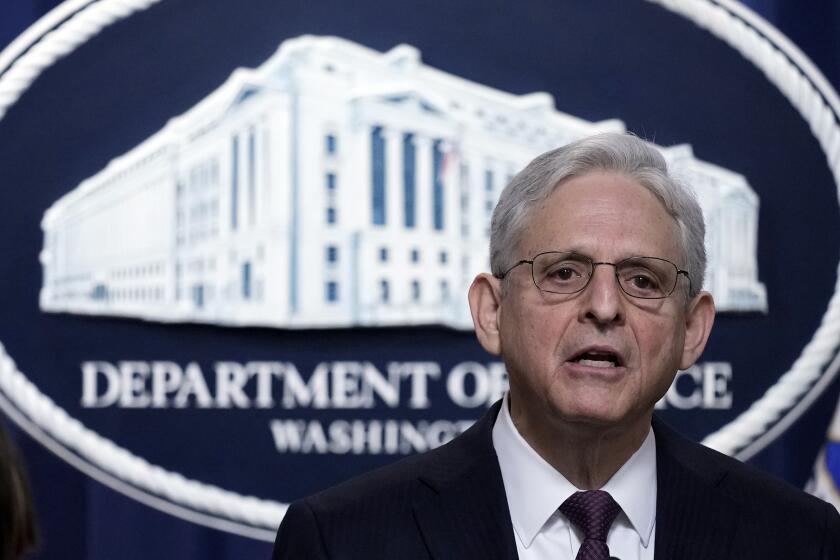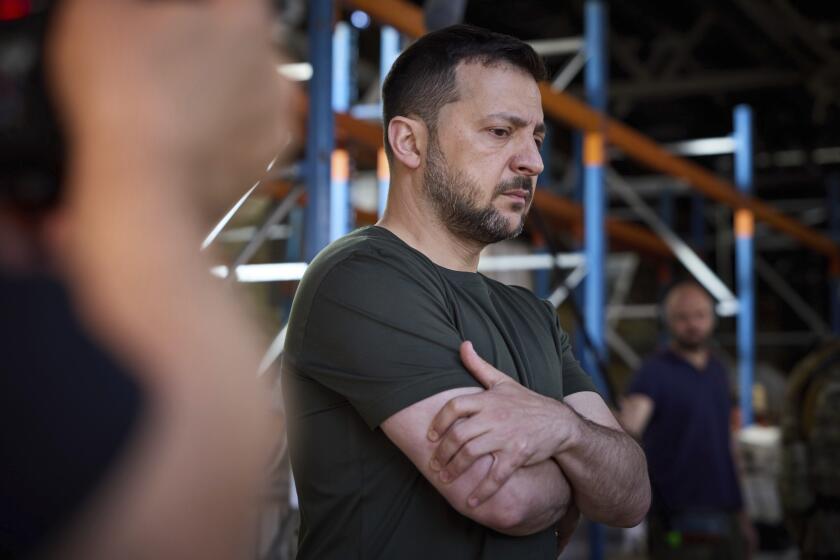3 Astronauts Grab Marooned Satellite in a Dramatic Rescue : Space: The manual capture is biggest step in an hours-long procedure to retrieve the craft. The crew is to bring it into the shuttle’s cargo bay to attach a booster rocket.
After two days of unsuccessful attempts, three jubilant space shuttle astronauts made history Wednesday, accomplishing a decidedly low-tech rescue of a marooned communications satellite by reaching out and grabbing it with their hands.
The manual capture was the first, but by far biggest step in an hours-long procedure to put the 17-foot-tall satellite in its intended orbit. The astronauts were to bring the Intelsat 6 satellite into the bay of the shuttle Endeavour, where they were to attach a small booster rocket before the satellite was jettisoned back into space by a set of springs.
The rocket was to be fired at an undetermined time, sending the satellite into a stationary orbit 23,200 nautical miles above the Atlantic Ocean.
After nearly three hours of preparations in the Endeavour’s open cargo bay, astronaut Richard J. Hieb, strapped to a small platform, gave the command to grab the wobbling Intelsat 6 at 4:59 p.m. PDT.
“Let’s do it,” Hieb told fellow astronauts Pierre J. Thuot, 36, and Thomas D. Akers, 40, as the Endeavour and the Intelsat 6 streaked high over the Pacific Ocean at 17,500 miles an hour. The three men, who conducted the first-ever spacewalk by three astronauts, then clutched the satellite with apparent ease.
Applause erupted from 50 technicians at Intelsat’s mission control center in Washington, D.C. Outside the center about 300 journalists from around the world and a handful of company executives watched on three big-screen televisions, as if it were NASA’s version of the Super Bowl.
The Endeavour crew retrieved the satellite after trying unsuccessfully for two days to secure it with a “capture bar” that cost $7 million to design and develop. The failure had the potential of becoming a black eye for the agency and a threat to its future funding.
Some foreign journalists gathered at Intelsat headquarters said they were interested because of the potential embarrassment to the agency. Indeed, before the satellite was successfully snatched, a former NASA consultant, now an industry lobbyist, said the agency’s failed performance thus far had already hurt its image on Capitol Hill, where NASA is struggling to get massive funding for a proposed space station.
Wednesday’s rescue followed 14 failed attempts on Sunday and Monday. On Sunday, Thuot sent the Intelsat 6 into an uncontrollable wobble after he made a solo attempt to snag it with the 15-foot “capture bar” that never worked as planned.
Flight controllers at the Washington headquarters of the International Telecommunications Satellite Organization, the 122-nation consortium that owns and operates the $150-million satellite, later were able to stabilize it.
“The training was fine. My sense is that the tool did not work as designed, which would not be the first time,” said former astronaut Joseph P. Allen, who was involved in a 1984 spacewalk and satellite rescue in which a tool intended to stabilize the errant PALAPA B-2 satellite did not work.
The Intelsat rescue marked the first time that astronauts used nothing but their hands to capture an orbiting satellite, according to officials at the National Aeronautics and Space Administration’s Johnson Space Center here.
The mission also was the first time that astronauts had carried aloft a rocket motor to boost a stranded satellite into high orbit.
The hand-capture involved significant risks for the $2-billion Endeavour, the $150-million satellite and the astronauts, who had only their gloved hands to prevent the massive satellite from crashing into the orbiter.
Even a light collision that damaged the open cargo bay doors could have been disastrous because the doors must be closed for the shuttle’s return to Earth. Damage to the shuttle’s tail section, which guides the orbiter on its descent, also could have proved fatal.
In addition, the astronauts could have been killed had a sharp edge on the satellite sliced through the five layers of material on their gloves and released the oxygen from their spacesuits.
But the virtually flawless flying by Endeavour commander Daniel C. Brandenstein, who controlled the shuttle by hand during the last 90 minutes before the rendezvous, averted problems.
“I have my toes, my fingers and my eyes crossed waiting for the mission,” NASA Administrator Daniel S. Goldin told the crew during a telephone call Tuesday night. “The one thing I ask you all to keep in mind is crew safety has got to be our first objective.”
NASA flight controllers delayed the beginning of the rendezvous for 90 minutes one orbit of the Earth--when they discovered a problem with the computer software aboard the shuttle used to track the satellite and aim the Endeavour toward it.
In the end, controllers at the space center transmitted their own targeting information to Endeavour pilot Kevin P. Chilton, 36, rather than rely on the suspect targeting data from the shuttle’s computers.
The delay kept the three spacewalkers stacked in the shuttle’s cramped airlock, the chamber that separates the interior of the orbiter from the 60-foot cargo bay, for more than an hour and a half.
About 2:15 p.m. PDT, Thuot, Hieb and Akers climbed out of the airlock into the open cargo bay, and began preparations.
One of their first tasks was to latch a triangular strut structure, which served as a platform for the rescue, to the walls of the cargo bay.
The struts are on board for a fourth spacewalk, now scheduled for today, when Akers and astronaut Kathryn C. Thornton will practice techniques for assembling space station Freedom.
After the struts were assembled, the spacewalkers tethered the troublesome capture bar to the cargo bay and unpacked tools they later used in the capture and grapple of the satellite. They also attached foot restraints to two of the strut arms.
At 3:15 p.m. PDT, Endeavour’s Brandenstein moved to the shuttle’s aft cockpit to take manual control of the spacecraft as he pulled it within a mile of the satellite, by then spinning at a rate of about once every four minutes.
As the spacecraft flew over Texas, Brandenstein flew the shuttle 1,750 feet below the satellite and then slowly pulled up the orbiter in front of the Intelsat, with the shuttle’s tail pointed toward the Earth.
More to Read
Start your day right
Sign up for Essential California for news, features and recommendations from the L.A. Times and beyond in your inbox six days a week.
You may occasionally receive promotional content from the Los Angeles Times.






